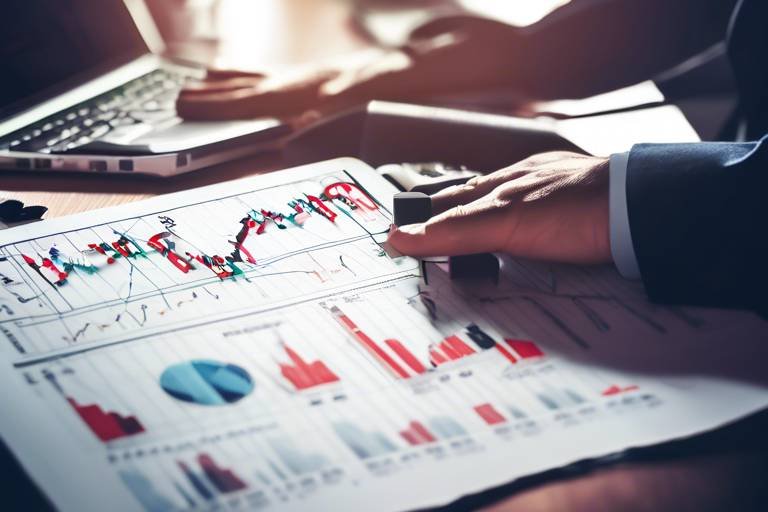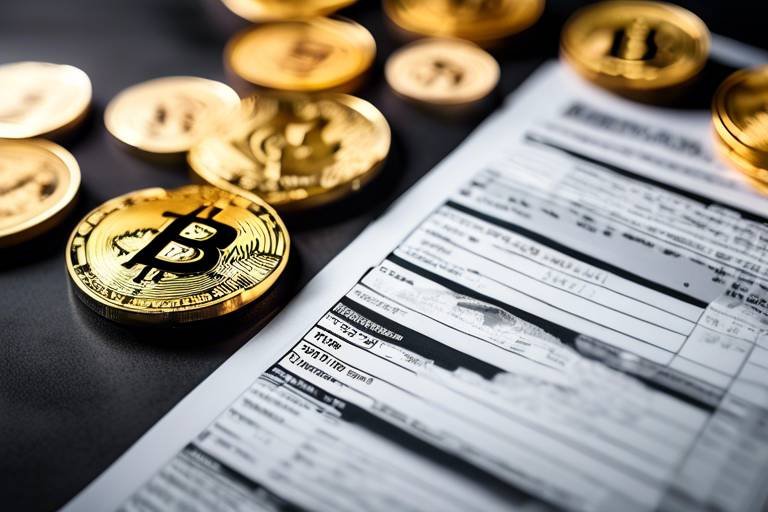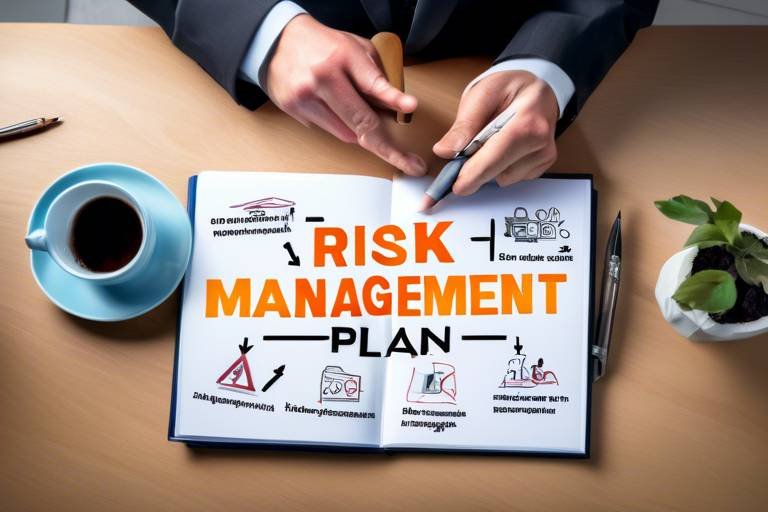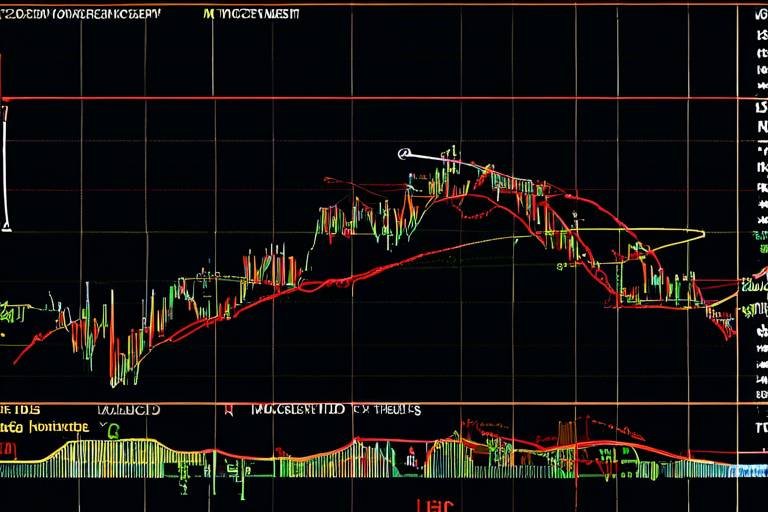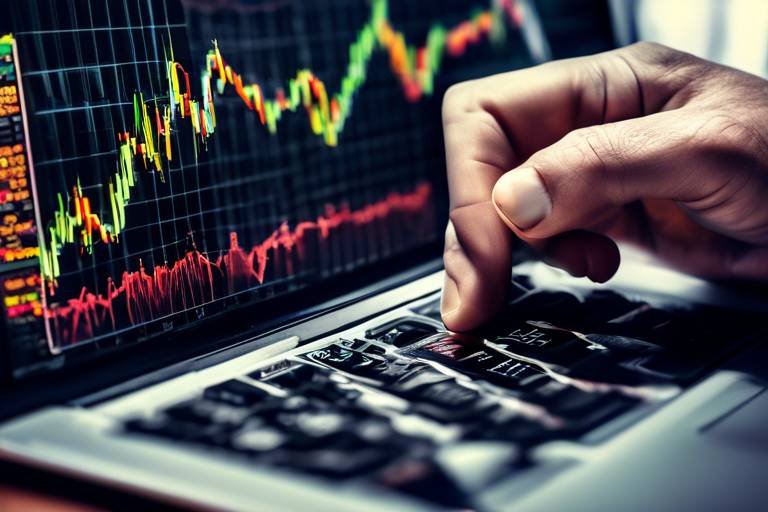How to Analyze Risk vs. Reward in Crypto Trading
In the thrilling world of cryptocurrency trading, the concept of risk versus reward is a fundamental principle that every trader should grasp. Imagine standing at the edge of a diving board, peering into the deep blue water below. The higher you jump, the greater the potential splash – but also the greater the risk of a belly flop. Similarly, in crypto trading, understanding the balance between the potential gains and the possible losses can make the difference between a successful trade and a costly mistake. This article aims to guide you through the essential elements of analyzing risk and reward, helping you navigate the often turbulent waters of crypto markets.
Risk in crypto trading refers to the potential for financial loss, and it’s something every trader must contend with. The cryptocurrency market is notorious for its high volatility, where prices can swing dramatically in mere minutes. This unpredictability is akin to riding a roller coaster – exhilarating, yes, but also potentially stomach-churning.
There are several types of risks that traders face, including:
- Market Volatility: The rapid price changes can lead to significant gains or losses.
- Liquidity Risk: This occurs when a trader cannot execute a trade quickly enough, leading to unfavorable prices.
- Regulatory Challenges: Changes in laws and regulations can impact the market and specific cryptocurrencies.
Understanding these risks is crucial for any trader looking to make informed decisions. By acknowledging the potential downsides, you can better prepare yourself to navigate the often unpredictable landscape of cryptocurrency trading.
Evaluating potential rewards is equally crucial for successful trading. In the crypto world, rewards can be enticing, but they come with their own set of challenges. Assessing potential gains requires a keen eye and an understanding of market dynamics. For instance, when analyzing a specific cryptocurrency, consider factors such as its market capitalization, historical performance, and upcoming technological developments.
To illustrate this, let’s take a look at a hypothetical scenario:
| Cryptocurrency | Market Cap ($) | Potential Gain (%) |
|---|---|---|
| Crypto A | 1,000,000 | 30% |
| Crypto B | 500,000 | 50% |
| Crypto C | 2,000,000 | 15% |
In this example, while Crypto B shows the highest potential gain, it may also carry higher risk due to its lower market cap and liquidity. Thus, evaluating potential rewards requires a careful balance between the allure of profit and the reality of risk.
The risk-reward ratio is a key metric for traders, acting as a compass to navigate the trading waters. It measures the potential profit of a trade against the potential loss. For instance, if you’re considering a trade with a potential profit of $300 and a potential loss of $100, your risk-reward ratio would be 3:1. This means for every dollar you risk, you stand to gain three.
To calculate this ratio, you can use the following formula:
Risk-Reward Ratio Potential Loss / Potential Profit
Understanding and interpreting this ratio can significantly enhance your trading strategies, allowing you to make more informed decisions that align with your financial goals.
Establishing target profit levels is essential for effective trading. Without clear targets, you might find yourself caught up in the excitement of the market, leading to impulsive decisions. Strategies for setting realistic profit targets include analyzing historical price movements, considering market trends, and aligning targets with your personal trading goals.
Implementing stop-loss orders is a vital risk management technique. These orders automatically sell your asset when it reaches a certain price, helping to protect your investments. Different stop-loss strategies can be employed, such as setting a fixed percentage below the entry price or using trailing stops that adjust as the price moves in your favor.
Understanding market trends is fundamental for analyzing risk and reward. Various market analysis techniques can enhance your trading strategies, including technical analysis (which focuses on price movements and patterns) and fundamental analysis (which examines the underlying factors that influence a cryptocurrency's value). By mastering these techniques, you can better predict market movements and make more informed trading decisions.
Psychology plays a significant role in trading decisions. Emotions such as fear and greed can cloud judgment and lead to poor decision-making. It’s essential to recognize how these psychological factors can impact your risk assessment and reward expectations in cryptocurrency trading.
Managing emotions is critical for successful trading. To maintain emotional control, consider techniques such as setting strict trading rules, taking breaks when feeling overwhelmed, and practicing mindfulness. These strategies can help you stay grounded, enabling you to make rational decisions even in high-pressure trading environments.
A well-structured trading plan is essential for consistent success. Your plan should include key components such as your risk tolerance, profit targets, and specific strategies for entering and exiting trades. By integrating risk and reward analysis into your trading plan, you can create a roadmap that guides your decisions and helps you stay focused on your long-term goals.
Q: What is the best way to manage risk in crypto trading?
A: The best way to manage risk is to use a combination of stop-loss orders, diversifying your portfolio, and setting clear profit and loss targets.
Q: How can I determine the right risk-reward ratio?
A: A common risk-reward ratio is 1:2 or 1:3, meaning for every dollar you risk, you aim to gain two or three. However, it ultimately depends on your trading strategy and market conditions.
Q: Why is psychology important in trading?
A: Psychology is crucial because emotions can influence decision-making. Recognizing and managing these emotions can lead to more rational and profitable trading choices.

Understanding Risk in Crypto Trading
When it comes to crypto trading, understanding risk is absolutely essential. After all, investing in cryptocurrencies can feel like riding a roller coaster—there are thrilling highs and terrifying lows. But what exactly does risk mean in this context? Simply put, risk refers to the potential for financial loss. In the world of crypto, this can manifest in various forms, making it crucial for traders to be aware of the different types of risks they might encounter.
One of the most significant risks in crypto trading is market volatility. The cryptocurrency market is notorious for its rapid price fluctuations. For instance, a coin could soar by 20% one day and plummet by the same percentage the next. This unpredictability can lead to substantial gains, but it can also result in equally substantial losses. Traders need to be prepared for these swings and should have strategies in place to manage their exposure.
Another risk to consider is liquidity risk. Liquidity refers to how easily an asset can be bought or sold in the market without affecting its price. In the crypto world, some lesser-known coins might have low trading volumes, making it difficult to exit a position without incurring significant losses. Imagine trying to sell a rare collectible at a flea market—if there aren’t enough interested buyers, you might have to settle for much less than you hoped for.
Additionally, regulatory challenges pose a significant risk for crypto traders. Governments around the globe are still figuring out how to handle cryptocurrencies, and sudden regulatory changes can impact the market dramatically. For example, a country might decide to ban certain cryptocurrencies or impose heavy taxes on crypto transactions, leading to sudden price drops. Traders must stay informed about the legal landscape and be prepared to adapt their strategies accordingly.
To summarize, understanding the various risks involved in crypto trading is vital for making informed decisions. Here’s a quick overview of the main types of risks:
- Market Volatility: Rapid price changes can lead to significant gains or losses.
- Liquidity Risk: Difficulty in buying or selling assets can affect profitability.
- Regulatory Challenges: Changes in laws can impact market conditions and prices.
By being aware of these risks, traders can develop strategies to mitigate them and make more informed decisions that align with their financial goals. Remember, the key to successful trading lies in balancing risk and reward, and understanding the risks is the first step in that process.

Evaluating Reward Potential
When it comes to crypto trading, evaluating potential rewards is like searching for hidden treasure in a vast ocean. The thrill of uncovering substantial gains is what drives many traders to dive into the tumultuous waters of cryptocurrency. However, just as a pirate must chart their course carefully, traders need to assess the potential rewards of their investments to ensure they're not sailing into a storm. Understanding how to evaluate these rewards can significantly impact your trading success and help you make informed decisions.
To begin with, it's crucial to recognize that the potential rewards in crypto trading are influenced by various factors. Market trends, the overall economic environment, and even technological advancements can all play a role in shaping the profitability of a trade. For instance, when a new cryptocurrency is launched, the initial hype can create a surge in demand, resulting in impressive short-term gains for early investors. However, this also comes with a caveat: the volatility of the crypto market means that these gains can evaporate just as quickly as they appear.
One effective way to evaluate reward potential is by analyzing historical performance data. By examining past price movements and trading volumes, traders can gain insights into how a particular asset has behaved under various market conditions. This analysis can be done using various tools, including:
- Technical Analysis: This involves studying price charts and patterns to predict future movements.
- Fundamental Analysis: This looks at the underlying factors that could affect the value of a cryptocurrency, such as its utility, adoption rate, and the team behind it.
- Sentiment Analysis: This gauges market sentiment through social media, news articles, and other platforms to understand how traders feel about a particular asset.
In addition to these analyses, setting realistic profit targets is essential. Traders often fall into the trap of overestimating potential gains, leading to disappointment when their expectations aren't met. Instead, consider establishing a risk-reward ratio to guide your trading decisions. This ratio helps you assess whether the potential reward justifies the risk involved. For instance, if you're considering a trade with a risk-reward ratio of 1:3, this means for every dollar you're willing to risk, you're aiming for three dollars in profit. This framework not only clarifies your trading strategy but also encourages discipline in your approach.
Ultimately, evaluating reward potential is about balancing optimism with caution. The crypto market is rife with opportunities, but it also poses significant risks. By conducting thorough analyses, setting realistic targets, and maintaining a level-headed approach, traders can enhance their chances of navigating the crypto seas successfully and reaping the rewards they seek.
As you embark on your trading journey, remember that the key to evaluating reward potential lies in informed decision-making. The more you understand the factors that influence potential gains, the better equipped you'll be to make choices that align with your financial goals.
Q: How can I determine if a cryptocurrency is worth investing in?
A: Start by conducting thorough research on the cryptocurrency, including its use case, technology, and the team behind it. Utilize both technical and fundamental analysis to gauge its potential.
Q: What is a good risk-reward ratio for trading?
A: A commonly recommended risk-reward ratio is 1:2 or 1:3, meaning for every dollar you risk, you aim to gain two or three dollars. This helps ensure that even if you have a few losing trades, your profitable trades can cover those losses.
Q: Should I always set profit targets?
A: Yes, setting profit targets helps you stay disciplined and avoid emotional decision-making. It provides a clear exit strategy, allowing you to lock in profits when your target is reached.

Risk-Reward Ratio Explained
The risk-reward ratio is a crucial metric that every trader should understand when navigating the turbulent waters of cryptocurrency trading. Essentially, it helps you evaluate the potential reward of a trade against the risk you are willing to take. Think of it as a balancing act: on one side, you have your potential gains, and on the other, the risk of loss. The goal is to maximize your gains while keeping your losses to a minimum. But how do you calculate this ratio, and why is it so important?
To calculate the risk-reward ratio, you simply divide the amount of money you stand to gain by the amount you risk losing. For example, if you enter a trade with the potential to gain $300 but risk losing $100, your risk-reward ratio would be 3:1. This means that for every dollar you risk, you stand to gain three. A higher ratio indicates a more favorable trade, while a lower ratio suggests that you might want to think twice before proceeding.
Here's a simple formula to illustrate this:
| Potential Gain | Potential Loss | Risk-Reward Ratio |
|---|---|---|
| $300 | $100 | 3:1 |
| $200 | $100 | 2:1 |
| $150 | $100 | 1.5:1 |
Now, you might be wondering, "What is a good risk-reward ratio?" While there is no one-size-fits-all answer, many traders aim for a ratio of at least 2:1. This means that for every dollar you risk, you should aim to make at least two. However, the ideal ratio can vary based on your trading style, market conditions, and personal risk tolerance. It's essential to find a balance that works for you.
In addition to calculating the risk-reward ratio, it's also vital to consider the probability of success. A trade with a high risk-reward ratio might not be worth taking if the likelihood of it being successful is low. Therefore, combining the risk-reward ratio with your analysis of market trends and other indicators can lead to more informed trading decisions.
In conclusion, understanding and applying the risk-reward ratio in your trading strategy can significantly impact your overall success. It’s not just about making money; it’s about making informed decisions that align with your financial goals. So, the next time you consider a trade, take a moment to calculate your risk-reward ratio. It could be the difference between a winning strategy and a costly mistake.

Setting Target Profits
Setting target profits is a crucial step in the trading journey, especially in the fast-paced world of cryptocurrency. Think of it as setting a finish line in a race; without it, you might run aimlessly, unsure of when to stop. The key to successful trading lies in having a clear goal for your profits, which can help you stay focused and disciplined. But how do you determine what that target should be? Well, it involves a blend of market analysis, personal trading goals, and a sprinkle of intuition.
First off, it's essential to analyze the market conditions before setting your profit targets. Look at historical price movements, current trends, and potential catalysts that could influence price changes. For instance, if a cryptocurrency has shown a consistent pattern of increasing by 10% after a major announcement, you might set your target profit around that percentage. However, remember that past performance is not always indicative of future results, so stay flexible and be ready to adjust your targets as new information arises.
Another effective strategy is to use the risk-reward ratio. This ratio helps you evaluate how much risk you're willing to take in relation to the potential reward. For example, if you're considering a trade where you're risking $100 to potentially gain $300, your risk-reward ratio is 1:3. This means that for every dollar you risk, you stand to gain three. Aiming for a risk-reward ratio of at least 1:2 is generally advisable, as it ensures that your potential rewards outweigh the risks involved.
Additionally, consider your personal trading goals and risk tolerance. Are you looking for quick gains, or are you in it for the long haul? If you're a day trader, you might set smaller, more frequent profit targets, while long-term investors may aim for more substantial gains over time. It’s all about aligning your targets with your overall trading strategy.
Finally, it’s crucial to remain disciplined once you've set your target profits. Many traders fall into the trap of greed, wanting to squeeze out just a little more profit before selling. This can lead to missed opportunities and, in some cases, losses. Instead, stick to your plan. If your target is reached, consider taking profits and reassessing your position. Remember, in trading, it’s better to have a series of small wins than to hold out for the big one and risk losing everything.
In conclusion, setting target profits is not just about numbers; it’s about strategy, analysis, and psychological discipline. By combining market insights with personal goals and maintaining a disciplined approach, you can enhance your trading performance and navigate the unpredictable waters of cryptocurrency trading more effectively.

Stop-Loss Strategies
When it comes to cryptocurrency trading, implementing effective is not just a good idea; it's a necessity. A stop-loss order acts as your safety net, allowing you to minimize potential losses while still participating in the market's thrilling ups and downs. Think of it as a parachute: you hope you never have to use it, but it’s comforting to know it’s there when you jump out of that plane!
There are several types of stop-loss strategies that traders can utilize, each with its own advantages and nuances. One common approach is the fixed stop-loss, where you set a specific price point at which your asset will be sold if it begins to decline. This method is straightforward and easy to implement, making it a popular choice among beginners. However, it can sometimes lead to premature exits during normal market fluctuations.
Another approach is the trailing stop-loss. This strategy allows you to set a stop-loss order that moves with the market price. For example, if you buy a cryptocurrency at $100 and set a trailing stop-loss of $10, your stop-loss will automatically adjust to $90 if the price rises to $110. This way, you can lock in profits while still giving your investment room to grow. It’s like having a loyal friend who nudges you to take profits at the right moment!
To illustrate the effectiveness of these strategies, consider the following table that compares fixed and trailing stop-loss orders:
| Type of Stop-Loss | Advantages | Disadvantages |
|---|---|---|
| Fixed Stop-Loss | Simple to set up; good for beginners | May lead to premature exits |
| Trailing Stop-Loss | Locks in profits; adapts to market movements | Can be complex; may not execute at the desired price |
Another important aspect to consider is the percentage-based stop-loss. This strategy involves setting your stop-loss at a specific percentage below your entry price. For instance, if you purchase a cryptocurrency at $100 and set a stop-loss at 10%, your stop-loss would trigger if the price drops to $90. This method allows you to tailor your risk tolerance based on market conditions and your personal financial situation.
Ultimately, the key to successful stop-loss strategies lies in regularly reviewing and adjusting your orders based on market trends and personal trading goals. As the market evolves, so should your strategies. Staying informed and adaptable can make all the difference between a successful trade and a costly mistake.
In conclusion, stop-loss strategies are an essential part of any trader's toolkit. Whether you choose fixed, trailing, or percentage-based stop-loss orders, the important thing is to have a plan in place. Remember, in the wild world of crypto trading, it's better to have a safety net and not need it than to need it and not have it!
- What is a stop-loss order? A stop-loss order is an instruction to sell an asset when it reaches a certain price, helping to limit potential losses.
- How do I determine my stop-loss level? Your stop-loss level should be based on your risk tolerance, market volatility, and trading strategy.
- Can I adjust my stop-loss order? Yes, you can modify your stop-loss order at any time to reflect changing market conditions or personal preferences.

Market Analysis Techniques
When it comes to navigating the tumultuous waters of cryptocurrency trading, understanding market analysis techniques is like having a compass in a storm. Without it, you might find yourself lost and vulnerable to the unpredictable waves of market volatility. So, what are these techniques that can help you steer your trading ship towards profitable shores? Let’s dive into the two primary approaches: technical analysis and fundamental analysis.
Technical analysis involves the examination of price charts and patterns to predict future price movements. Traders who rely on this method often use various indicators, such as moving averages, Relative Strength Index (RSI), and Bollinger Bands, to identify trends and potential entry or exit points. For instance, a trader might observe that a cryptocurrency has consistently bounced off a specific support level, indicating a potential buying opportunity. However, it's essential to remember that while technical analysis can provide insights, it does not guarantee results—market conditions can change in an instant.
On the other hand, fundamental analysis focuses on the underlying factors that influence a cryptocurrency's value. This includes evaluating the technology behind the coin, the team involved, market demand, and regulatory news. For example, if a new partnership is announced that enhances a cryptocurrency's utility, this could lead to a surge in demand and, consequently, its price. In this way, understanding the fundamentals can offer traders a broader perspective on potential long-term profitability.
Both analysis techniques have their strengths, and many traders find that a combination of the two provides a more comprehensive view of the market. By using technical analysis to time their trades and fundamental analysis to assess the overall health of a cryptocurrency, traders can make more informed decisions. It's like having a two-pronged approach: one eye on the charts and the other on the news.
To further illustrate the differences between these two methodologies, consider the following table:
| Aspect | Technical Analysis | Fundamental Analysis |
|---|---|---|
| Focus | Price movements and patterns | Underlying value and factors |
| Tools | Charts, indicators, and patterns | News, reports, and market conditions |
| Timeframe | Short-term trading | Long-term investment |
| Psychological Factors | Market sentiment reflected in price | Investor behavior and market trends |
In conclusion, mastering market analysis techniques is essential for any trader looking to thrive in the crypto space. By honing your skills in both technical and fundamental analysis, you can enhance your ability to assess risk and reward effectively. Remember, the goal is not just to survive the market but to navigate it with confidence and strategic insight. So, are you ready to put these techniques into practice and elevate your trading game?
- What is the best analysis technique for beginners? Starting with technical analysis can be beneficial for beginners as it provides clear visual cues and patterns to follow.
- Can I rely solely on technical analysis? While technical analysis is valuable, it's wise to incorporate fundamental analysis for a more rounded understanding of the market.
- How often should I analyze the market? Regular analysis is key; many traders check the market daily, while others may do it multiple times a day depending on their trading strategy.

Psychological Factors in Trading
When it comes to crypto trading, the mind can be both your best friend and your worst enemy. It's fascinating how the psychological factors at play can significantly influence your trading decisions. Have you ever found yourself second-guessing a trade just because of a sudden market dip? Or maybe you felt an overwhelming urge to buy when everyone else was? These emotional responses are common, and understanding them is crucial for success in the volatile world of cryptocurrency.
One of the biggest challenges traders face is the impact of emotions. Fear and greed often drive decisions, leading to impulsive actions that can derail even the most well-thought-out strategies. For instance, when prices drop, fear can trigger panic selling, causing you to exit a position prematurely. Conversely, in a bull market, the fear of missing out (FOMO) can push traders to buy at inflated prices, setting them up for potential losses. Recognizing these emotional triggers is the first step toward mastering your trading psychology.
Moreover, cognitive biases can cloud judgment. For example, the confirmation bias leads traders to seek information that supports their existing beliefs while ignoring contradictory data. This can skew your analysis and result in poor trading decisions. Another common bias is the loss aversion phenomenon, where traders are more affected by losses than by equivalent gains. This can lead to holding onto losing trades longer than necessary, hoping for a rebound that may never come.
So, how do you manage these psychological factors? One effective strategy is to establish a trading plan. A well-structured plan acts as a roadmap, guiding you through the emotional ups and downs of trading. It should include clear entry and exit points, risk management strategies, and profit targets. By adhering to your plan, you can reduce the influence of emotions and make more rational decisions. Additionally, consider incorporating the following elements into your trading plan:
- Set realistic goals: Aim for achievable targets to avoid disappointment.
- Maintain a trading journal: Document your trades and emotions to identify patterns over time.
- Practice mindfulness: Techniques such as meditation can help you stay calm and focused during high-pressure situations.
Another essential aspect of trading psychology is emotional control. It's vital to develop techniques that help you stay composed, especially during market volatility. Techniques such as deep breathing, taking breaks, or stepping away from the screen can help you regain your composure when emotions run high. Remember, the market will always be there, but your mental well-being is paramount.
In conclusion, the psychological factors in trading are as critical as the technical and fundamental aspects. By understanding and managing your emotions, recognizing cognitive biases, and adhering to a solid trading plan, you can enhance your decision-making process and improve your overall trading performance. The road to becoming a successful trader is not just about numbers; it's also about mastering the mind.
- What role do emotions play in trading? Emotions like fear and greed can lead to impulsive decisions, affecting trading outcomes.
- How can I manage my trading psychology? Establishing a trading plan, practicing mindfulness, and maintaining a trading journal can help manage emotions.
- What is loss aversion? Loss aversion is a cognitive bias where traders feel the pain of losses more acutely than the pleasure of gains, leading to poor decision-making.

Managing Emotions
When it comes to crypto trading, managing your emotions is like being the captain of a ship in a stormy sea. Just as a captain must remain calm and focused to navigate through choppy waters, you too must maintain your composure to make sound trading decisions. Emotions such as fear and greed can cloud your judgment, leading to impulsive actions that may result in significant losses. So, how can you keep your cool?
First, it’s crucial to recognize the emotional triggers that can lead to poor trading decisions. For instance, watching a cryptocurrency's price skyrocket might ignite a sense of urgency that pushes you to buy impulsively. Conversely, seeing a sudden drop could evoke panic, prompting you to sell hastily. Acknowledging these feelings is the first step in managing them. You might consider keeping a trading journal to document your emotional state during trades. This practice can help you identify patterns and triggers over time.
Another effective strategy is to set clear rules for your trading activities. Establishing guidelines can act as a safety net during turbulent times. For example, you can set specific entry and exit points based on your analysis, which will help you stick to your plan rather than react to market fluctuations. Implementing a trading checklist can also be beneficial. This checklist might include:
- Confirming your analysis before placing a trade
- Setting stop-loss orders to protect your capital
- Reviewing your emotional state before executing a trade
Moreover, practicing mindfulness techniques can significantly enhance your emotional control. Engaging in activities such as meditation or deep-breathing exercises can help you center yourself and reduce anxiety. Imagine you’re taking a step back from the chaos of the market, allowing yourself to breathe and refocus. This mental clarity can be a game-changer when you’re faced with high-pressure situations.
Lastly, consider the importance of taking breaks. The crypto market operates 24/7, which can create a sense of urgency to always be "on." However, stepping away from your screens can provide you with a fresh perspective. Just like athletes need rest to perform at their best, you too need time to recharge your mental batteries. Regular breaks can help you return to trading with a clearer mind and a more balanced emotional state.
In summary, managing emotions in crypto trading is not just about avoiding bad decisions; it’s about creating a sustainable and enjoyable trading experience. By recognizing your emotional triggers, establishing clear trading rules, practicing mindfulness, and taking necessary breaks, you can navigate the volatile waters of cryptocurrency with confidence and poise.
- How can I control my emotions while trading? Start by identifying your emotional triggers, setting clear trading rules, and practicing mindfulness techniques.
- Is it important to take breaks while trading? Yes, taking breaks can help you maintain a fresh perspective and prevent burnout.
- What role does a trading journal play? A trading journal helps you document your emotional state and identify patterns in your trading behavior.

Building a Trading Plan
Creating a robust trading plan is akin to drawing a roadmap before embarking on a journey. Without it, you're likely to get lost in the chaotic world of cryptocurrency trading, where prices can swing wildly and emotions can run high. A well-crafted trading plan not only outlines your trading strategies but also integrates essential elements of risk and reward analysis. Think of it as your personal guide that keeps you focused on your goals while helping you navigate through the uncertainties of the market.
To start building your trading plan, consider the following key components:
- Goals and Objectives: Clearly define what you want to achieve with your trading activities. Are you aiming for short-term gains, long-term investments, or a combination of both? Setting specific, measurable goals will help you stay on track and evaluate your progress.
- Risk Tolerance: Assess your risk appetite. How much capital are you willing to risk on each trade? Understanding your risk tolerance will guide your position sizing and help you avoid emotional trading decisions.
- Market Analysis: Incorporate both technical and fundamental analysis into your plan. This will enable you to make informed decisions based on market trends, price patterns, and news events that could impact the crypto landscape.
- Entry and Exit Strategies: Define your criteria for entering and exiting trades. Specify the indicators or signals that will prompt you to buy or sell, and determine your profit-taking and stop-loss levels to manage risk effectively.
- Review and Adaptation: A trading plan is not a one-time effort. Regularly review your performance and adapt your strategies based on what works and what doesn’t. This iterative process is crucial for long-term success.
Moreover, it's essential to document your trading activities. Keeping a trading journal allows you to track your trades, reflect on your decision-making process, and identify patterns in your behavior. This self-reflection can lead to improved strategies and better emotional control over time.
In conclusion, building a trading plan is a vital step in your trading journey. It provides clarity, structure, and a sense of direction, which are crucial in the fast-paced world of crypto trading. By integrating risk and reward analysis into your plan, you can make more informed decisions that align with your financial goals and ultimately enhance your trading success.
Q: How often should I review my trading plan?
A: It's recommended to review your trading plan at least once a month or after significant market events. This will help you stay aligned with your goals and adapt to changing market conditions.
Q: What is the most important aspect of a trading plan?
A: While all components are important, having a clear risk management strategy is crucial. It helps protect your capital and ensures that you can continue trading even after losses.
Q: Can I use the same trading plan for different cryptocurrencies?
A: Yes, but you may need to adjust certain elements based on the unique characteristics of each cryptocurrency. Factors like volatility, liquidity, and market sentiment can vary significantly from one coin to another.
Frequently Asked Questions
- What is the risk-reward ratio in crypto trading?
The risk-reward ratio is a crucial metric that helps traders evaluate the potential profit against the potential loss of a trade. For instance, if you're risking $100 to potentially gain $300, your risk-reward ratio is 1:3. This means for every dollar you risk, you could earn three if the trade goes well. Understanding this ratio can significantly enhance your trading strategy.
- How can I manage risk while trading cryptocurrencies?
Managing risk in crypto trading involves several strategies. One effective method is to use stop-loss orders, which automatically sell your assets when they reach a certain price, limiting your losses. Additionally, diversifying your portfolio and only investing what you can afford to lose are essential practices to help mitigate risk.
- What factors should I consider when evaluating potential rewards?
When assessing potential rewards, consider market trends, historical price movements, and the overall market sentiment. It's also important to analyze the specific cryptocurrency's fundamentals, such as its technology, use case, and community support, as these can greatly influence its future price potential.
- How do psychological factors affect trading decisions?
Psychological factors play a significant role in trading since emotions like fear and greed can lead to impulsive decisions. Traders often fall victim to biases, such as confirmation bias, where they seek information that supports their existing beliefs. Maintaining emotional discipline and sticking to a well-defined trading plan can help mitigate these effects.
- What are some effective stop-loss strategies?
Effective stop-loss strategies include setting a fixed percentage loss, using trailing stops that adjust as the price moves in your favor, and employing volatility-based stops that consider market fluctuations. Each strategy has its advantages, so it's essential to choose one that aligns with your trading style and risk tolerance.
- Why is building a trading plan important?
A well-structured trading plan is vital because it provides a roadmap for your trading activities. It helps you define your goals, risk tolerance, and strategies for entering and exiting trades. By having a clear plan, you can make more informed decisions and reduce the likelihood of emotional trading.


